The object of the Red Wing project was "To determine the optimum economic uses of electricity in agriculture and to study the value of electricity in improved living conditions on the farm." Although not the first service to farms in the U.S., it was likely the first built as an experiment specifically for collecting and publishing engineering and economic data.
Mechanization
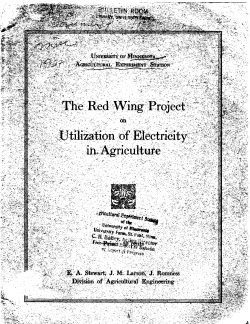

On June 30, 1857, James Oliver filed a patent application for chilling the wear face of cast-iron moldboard plows. While pouring molten cast iron in sand molds he circulated hot water through chillers to regulate the rate of cooling. Oliver's control of raw material content and cooling produced moldboards with a very hard surface and a softer, tough inner core for strength. Their fine textured wearing faces of uniform hardness maintained a mirror polish and resisted rust.
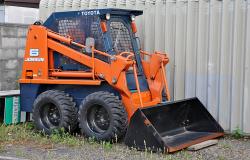
Brothers Cyril and Louis Keller designed and built the first small, lightweight, three-wheel, front-end loader in their machinist-blacksmith shop in Rothsay, Minnesota. A local farmer wanted to mechanize cleaning manure from his obstacle-filled, two-story turkey barn. The machine, first used in 1957, was able to turn completely around within its own length. Melroe Manufacturing Company, Gwinner, ND purchased the rights to the Keller loader and hired the Kellers to continue development of the loader in 1958.

In 1941, near Palouse, Washington, Raymond A. Hanson conceived of a self-leveling mechanism for hillside combines. On the steep hills in the Pacific Northwest, leveling is necessary to save grain because of the gravity grain separation mechanism. Before the Hanson invention, manual leveling required a person to stand on the combine platform and adjust the machine to the lay of the land - a hot, tedious job. The grain-saving attributes of Hanson's invention were probably more important than the labor saving, although both were valuable.

The concept of once-over mechanical, as opposed to multiple-pick hand or experimental multiple-pick machine harvesting, represented a major break-through in the practice of producing vine fruit such as pickling cucumbers. In the 1950s the cost of hand harvesting was as high as 50% of the production cost. Once-over mechanical harvesting, coupled with increasing plant population, reduced this cost to 25% thereby making production economically viable.
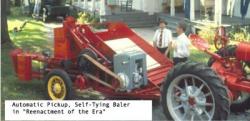
This machine is the world's first successful automatic pickup, self-tying hay baler. Its invention was a significant contribution to the development of American Agriculture. The baler was invented and hand-built in 1937 at Farmersville, Pa., a few miles from here. After testing and improvement, some production models were made at Kinzers, Pa. Balers of this type were first mass-produced in 1940 by the New Holland Machine Company. Dedicated by American Society of Agricultural Engineers 1976
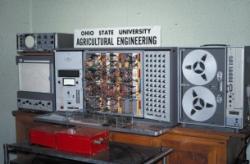
The first laser grade control was developed by agricultural engineers James Fouss and Norman Fausey of USDA's Agricultural Research Service at The Ohio State University in the mid-1960's. That system controlled the precise depth and grade of subsurface drains by regulating trenching and plow-type drainage machines. Photo cells mounted on the drainage machine automatically raised and lowered the digging device, keeping the cells centered on a laser beam set to the desired elevation and grade.
matic grade‐control system on the plow.
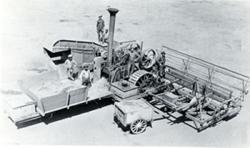
George Stockton Berry (1847-1917) of Lindsay, Tulare County, California designed, built, and in 1886, operated the first self-propelled combine. He was granted a U.S. Patent (# 374,339) in1887. The Berry design embodied the following "firsts":
Innovations
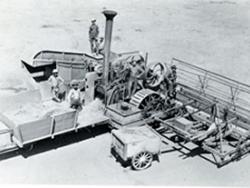
George Stockton Berry (1847-1917) of Lindsay, Tulare County, California designed, built, and in 1886, operated the first self-propelled combine. He was granted a U.S. Patent (# 374,339) in1887. The Berry design embodied the following "firsts":
1. Self-propelled combine.
2. Combine…
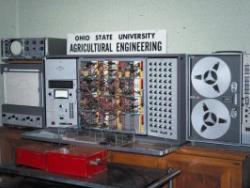
The first laser grade control was developed by agricultural engineers James Fouss and Norman Fausey of USDA's Agricultural Research Service at The Ohio State University in the mid-1960's. That system controlled the precise depth and grade of subsurface drains by regulating trenching and…
Read More
This machine is the world's first successful automatic pickup, self-tying hay baler. Its invention was a significant contribution to the development of American Agriculture. The baler was invented and hand-built in 1937 at Farmersville, Pa., a few miles from here. After testing and…
Read More
The concept of once-over mechanical, as opposed to multiple-pick hand or experimental multiple-pick machine harvesting, represented a major break-through in the practice of producing vine fruit such as pickling cucumbers. In the 1950s the cost of hand harvesting was as high as 50% of the…
Read More
In 1941, near Palouse, Washington, Raymond A. Hanson conceived of a self-leveling mechanism for hillside combines. On the steep hills in the Pacific Northwest, leveling is necessary to save grain because of the gravity grain separation mechanism. Before the Hanson invention, manual…
Read More
Brothers Cyril and Louis Keller designed and built the first small, lightweight, three-wheel, front-end loader in their machinist-blacksmith shop in Rothsay, Minnesota. A local farmer wanted to mechanize cleaning manure from his obstacle-filled, two-story turkey barn. The machine, first…
Read More
On June 30, 1857, James Oliver filed a patent application for chilling the wear face of cast-iron moldboard plows. While pouring molten cast iron in sand molds he circulated hot water through chillers to regulate the rate of cooling. Oliver's control of raw material content and…
Read More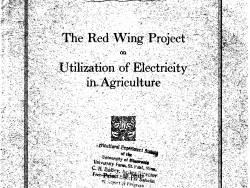
The object of the Red Wing project was "To determine the optimum economic uses of electricity in agriculture and to study the value of electricity in improved living conditions on the farm." Although not the first service to farms in the U.S., it was likely the first built as an…
Read More

